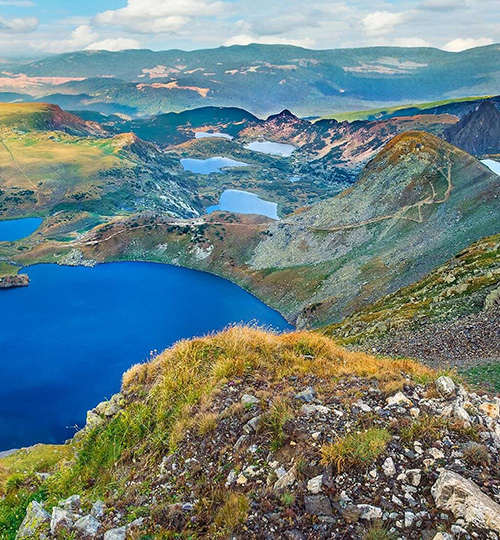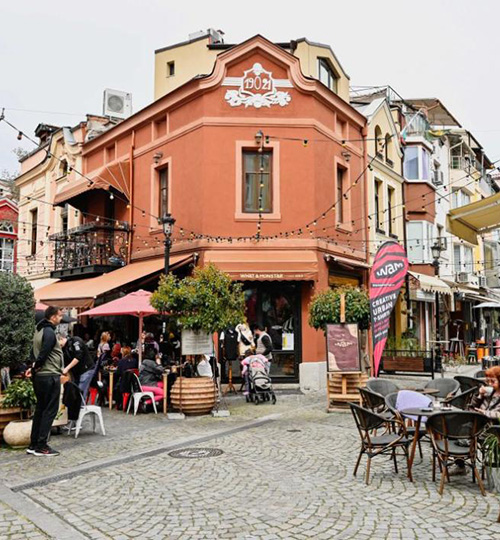Last Minute Deals
All discounts are automatically calculated by the system and the price we will be showing during the booking process is your final price.
The Seven Rila Lakes
The Seven Rila Lakes are without a doubt one of the most notable natural attractions on the Balkan Peninsula, a dream destination not to be missed. Their beauty touches the thousands of Bulgarian and international visitors who visit them.
The Seven Rila Lakes, located in the Dangskiya region of the northwestern Rila Mountains, are glacial lakes. They are scattered at the foot of a massive cirque that includes the peaks Suhi Chal (Dry Peak), Otovishki, and Haramiya. The lakes have been named for their shapes and qualities. The highest of them is Tear Lake, which gained its name for its crystal-clear water. It is 2,535 meters high, directly beneath the Otovishki Peak. Next is Eye Lake, the deepest of the seven at 37.5 meters. It is oval and
intense blue when the weather is good. Divers have explored this lake to gain further information about it. Somewhat lower than Eye Lake is Kidney Lake, named for its kidney shape, which has a surface area of 85 hectares and steep rocky banks. Next comes the Twins. Wide at both ends and narrow in the middle the lake resembles an hourglass. During dry years, the lake transforms into two smaller ones, and this is the source of its name. Farther down the trail are Three-leafed Lake and Fish Lake. The Seven Lakes Shelter is on the banks of Fish Lake. The lowest lake is appropriately called Lower Lake, which feeds the Dzherman River. The lakes are all connected by narrow streams.
Fish live in some of the lakes – minnows and trout – but in general, these high mountain lakes are unsuitable habitat for marine life because of their frigid water temperature, fed by rain and snowmelt.
Every year on August 19, there is a large gathering of the White Brotherhood or Danovites, who congregate to celebrate their New Year. The celebration takes place near Kidney Lake and consists of ritual rhythmic unison dancing in a large circle. For the Danovites, the Rila Mountains are a holy place where thousands of devotees gather every year to greet the dawn dawn.

Memorial Temple “St. Alexander Nevski” – Sofia City
The cathedral temple “St. Alexander Nevski” is considered a symbol of the Bulgarian capital. It is located in the center of Sofia, at the eponymous square. The reflection of its golden domes attracts attention from miles away.
The temple was built in honor of the Russian Emperor Alexander the 2nd, also known as the Tsar – Liberator, whose army liberated Bulgaria of the five-century long Ottoman Dominion in 1878. St. Alexander Nevski, whose name the cathedral bears, was a Russian prince (lived 1220 – 1263) – a great military commander and diplomat. He is a saint, patron of the Russian Emperor Alexander II and is a symbol of the Russian military glory.
The temple was built on the proposal of the Bulgarian politician and public figure Petko Karavelov (1843 – 1903). Initially, it was decided to build the temple in Veliko Tarnovo, but the Bulgarian Knyaz Battenberg (ruled 1879 – 1886) insisted on it to be in Sofia. Part of the funds for the temple construction was granted by the state budget and donations from prominent citizens, including Knyaz Battenberg, who donated 6,000 golden leva.
The foundation stone was laid on 19 February 1882, but the construction began later – in 1904. The temple was completed as late as in 1912 and was sanctified in 1924.
By an old custom, a metal box with the names of the government members and the reasons for the building of the temple was embedded in the building foundations. The designers sought help in Russia. 5 ready projects were sent from Sankt Petersburg. Knyaz Battenberg chose the project of architect Bogomolov, but the project was later rejected due to various reasons. Meanwhile, Bogomolov died and the eminent professor of the Art Academy in Sankt Petersburg – Alexander Pomerantsev was chosen for a chief architect.
The building covers an area of 3,170 square meters and can accommodate up to 5,000 people. The whole building was lined with white Vratsa stones; the entrance doors were made of Slavonia oak. The domes of the temple are covered with gold. The bell tower is 53 meters high and has 12 bells, the heaviest of them weighing 12 tons, and the smallest one – 10 kg. Their ringing can be heard from a radius of 15 kilometers.
The temple interior is unique – it impresses with its magnificent marble decorations, with its mural paintings and 82 icons, made by Bulgarian, Russian and Czech artists. The marble iconostasis, the royal and patriarchal thrones and the pulpit are of greatest interest for the visitors of the temple. Another valuable item is the mosaic mural of Tsar Ferdinand (ruled 1887 – 1918) and Queen Eleanor.
The temple celebrates two memorial days since 1946: 12 September – the carrying of St. Alexander Nevski’s relics to Saint Petersburg and 23 November – the day of the Assumption of St. Alexander Nevski.
The crypt is located in the basement of the church – it has a collection of icons, where visitors can see many masterpieces of the iconic art paintings.
As a monument, the temple has no parish and doesn’t offer other services besides the daily, Sunday and Festival worshipping, such as baptism, weddings and funerals, only with some exceptions – the wedding of Tsar Boris III (ruled 1918 – 1943) with Princess Giovanna of Savoy in 1930, his funeral in 1943 and the funerals of Patriarch Cyril in 1971 and the funeral of the great opera singer Boris Hristov in 1993.
Nowadays St. Alexander Nevski is the second largest Orthodox cathedral on the Balkan Mountain.

Nesebar Town
The town of Nesebar (with a population of 10 000 people) is situated on the Black Sea Shore, 36 km northeast of Burgas. It is close to another big Bulgarian resort – Slanchev bryag (Sunny Beach).
Nesebar Region has a temperate continental climate. The average temperature in the month of July is +23.1°C, and +2°C in January. The month with most precipitation is September. July and August are characterised by dry weather.
The town was established more than 3200 years ago. Thracians settled there at the end of the Bronze Age. They called it Melsambria, which meant the town of Melsas – that was probably the name of the founder of the settlement.
Today, the old and the new part of the town are connected by a narrow isthmus. The old town lies on a small peninsula. Because of its exceptional cultural and historical value, Nesebar was declared a museum, tourist, and resort complex of international importance by virtue of Ordinance No 243 of the Council of Ministers of 18 July 1956. In 1983 Old Nesebar was included in the List of World Cultural Heritage Sites of UNESCO.
Tourists can get more information about the history and the development of the town at the Archaeological Museum which is located at the very beginning of the peninsula. It exhibits finds discovered during archaeological excavations. The traces of past historical periods are everywhere. Part of the fortification wall can be seen in the Old Town. It was declared an architectural-construction monument of culture of national importance by virtue of publication in State Gazette, issue No 41 of 1964. A number of churches have been preserved and two of them – St. Spas Church and S. Stefan Church, have been transformed into museums.
Many of the houses in the Old Town were built during the Bulgarian Revival Period (18th – 19th centuries). The architectural design of Moskoyani House, where the exhibition of the Ethnographic Museum of Nesebar is housed, is interesting. Visitors can learn many things about the life and the culture of the people of Nesebar. Various everyday objects and traditional costumes are displayed there.

Plovdiv – the sixth oldest city in the world
Plovdiv is the second-largest city in Bulgaria and the cultural capital of the country. It is the oldest city in Europe and the sixth oldest in the world, where life has never stopped (The Daily Telegraph in 2010). In 2019 Plovdiv won the title of European Capital of Culture. The city is situated on both banks of the Maritsa River and between 7 hills in the historical region of Thrace. Plovdiv joined the UNESCO Global Network of Learning Cities in 2016.
Plovdiv is among the few cities with two ancient theatres; remains of the medieval walls and towers; Ottoman baths and mosques; a well-preserved old quarter from the National Revival period with beautiful houses; churches; and narrow paved streets. There are numerous museums and art galleries. Plovdiv is host to musical, theatrical, and film events.
Don’t miss to see:
- “Kapana” district – the area in the city centre dedicated to the creative industries
- The Roman Stadium in the heart of the city
- The Ancient Theatre – one of the best preserved in the World
- The Old Town of Plovdiv with its splendid Bulgarian Revival-style wooden-frame houses dating back to 18th and 19th c
- The good food and the local craft beer in the cosy restaurants in Kapana district


